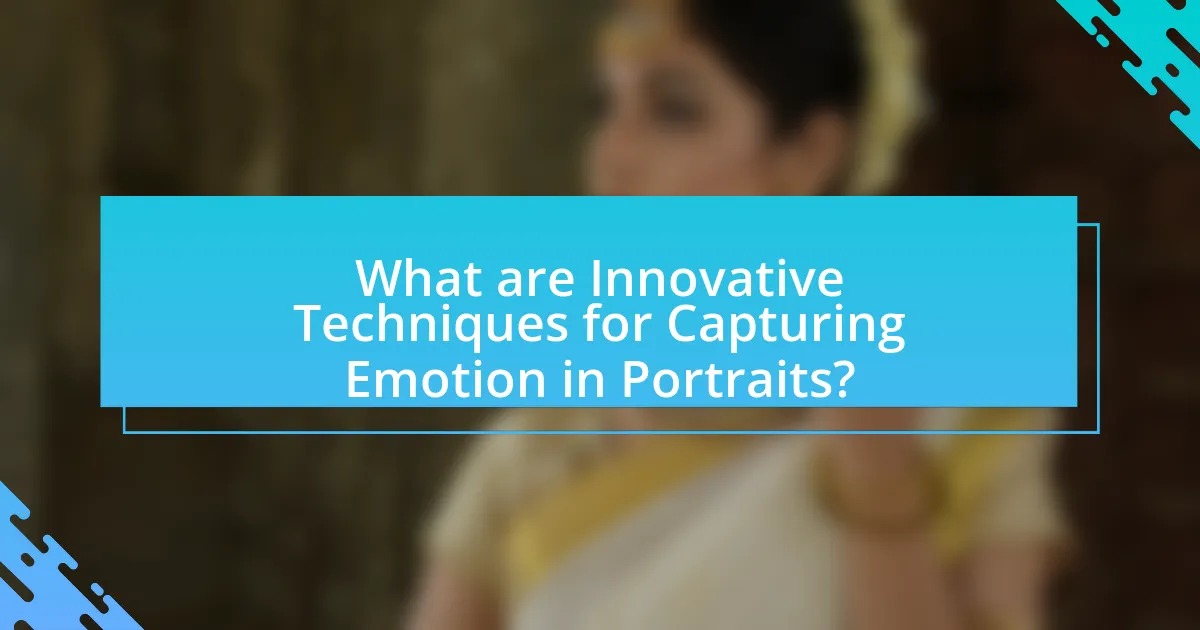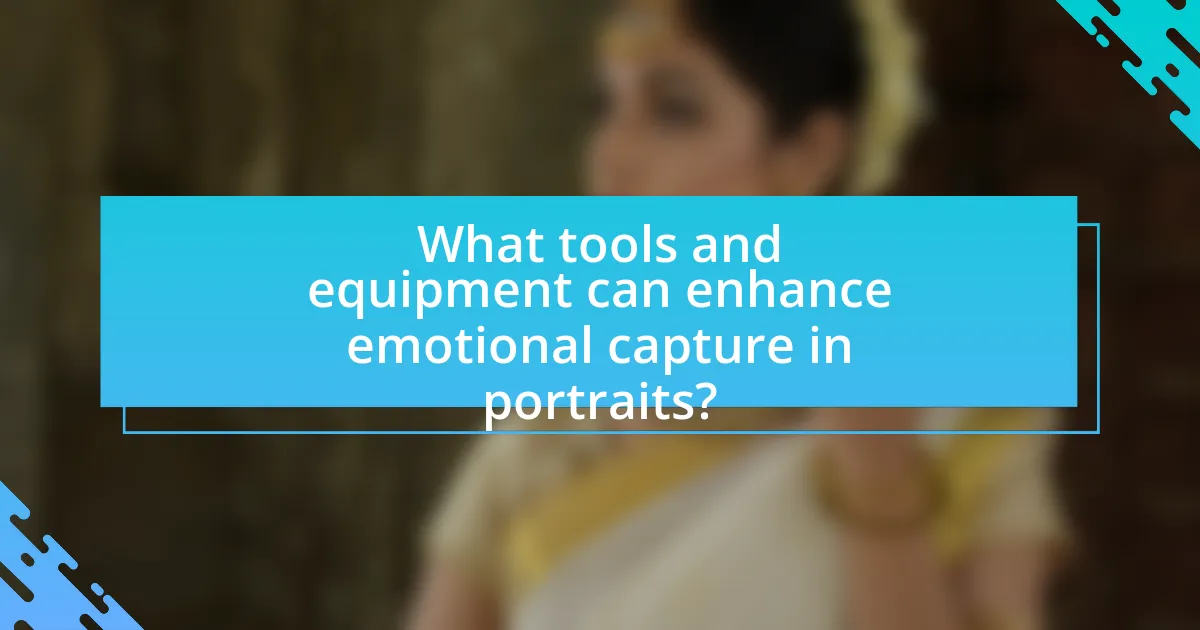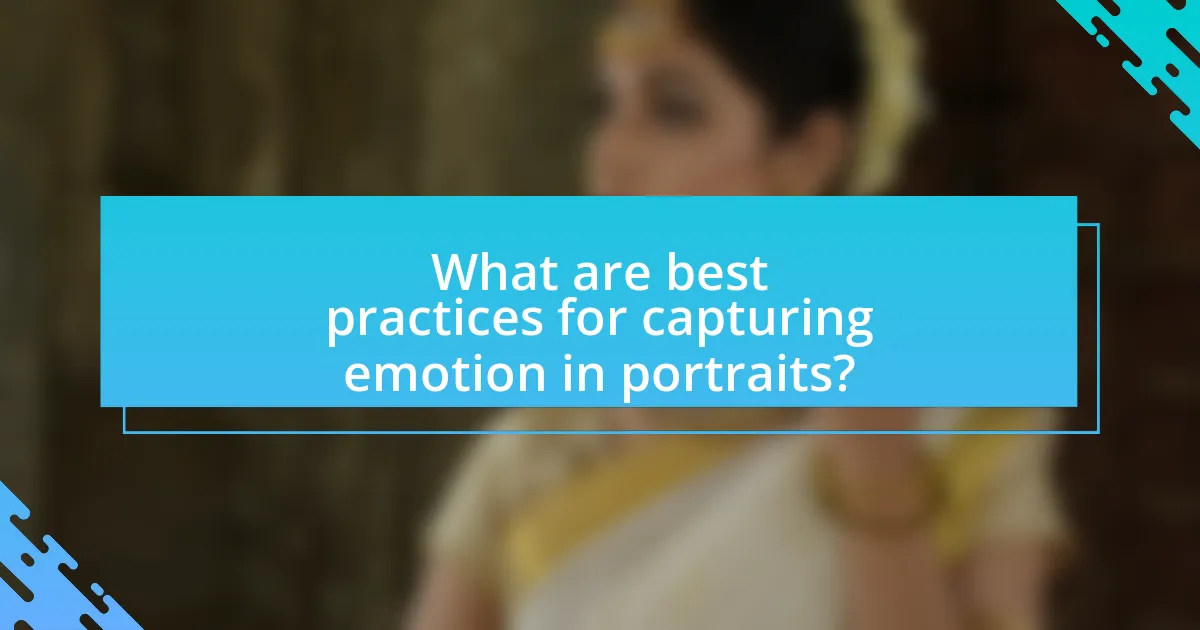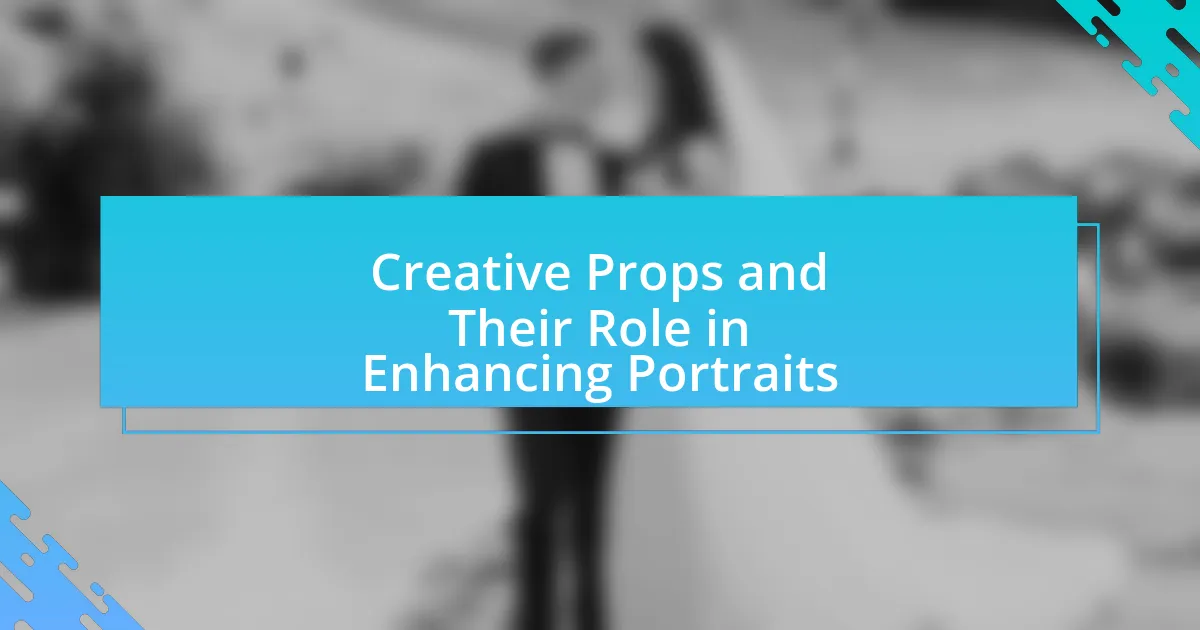The article focuses on innovative techniques for capturing emotion in portrait photography, emphasizing methods such as natural light, candid moments, and psychological prompts. It contrasts these approaches with traditional portrait photography, highlighting the importance of authenticity and emotional connection. Key elements defining innovative techniques include originality, adaptability, and the integration of new technologies. The article also discusses how lighting, composition, and props can enhance emotional expression, as well as best practices for photographers to create a comfortable environment that fosters genuine emotional responses from subjects. Additionally, it addresses common challenges and mistakes in capturing emotion, providing practical tips for improvement.

What are Innovative Techniques for Capturing Emotion in Portraits?
Innovative techniques for capturing emotion in portraits include the use of natural light, candid moments, and psychological prompts. Natural light enhances the subject’s features and creates a more authentic atmosphere, which can evoke genuine emotions. Candid moments, where subjects are engaged in activities or interactions, often reveal unguarded expressions that convey deeper feelings. Psychological prompts, such as asking subjects to recall a meaningful memory or to express a specific emotion, can elicit more profound emotional responses, resulting in portraits that resonate with viewers. These techniques are supported by studies in photography that emphasize the importance of authenticity and emotional connection in visual storytelling.
How do these techniques differ from traditional portrait photography?
Innovative techniques for capturing emotion in portraits differ from traditional portrait photography primarily in their approach to subject interaction and emotional expression. While traditional portrait photography often emphasizes posed subjects and controlled environments, innovative techniques focus on candid moments, dynamic compositions, and the use of natural light to evoke genuine emotions. For instance, methods such as environmental portraiture or documentary-style photography capture subjects in their natural settings, allowing for more authentic expressions and interactions. This shift towards spontaneity and context enhances the emotional depth of the images, making them resonate more with viewers.
What are the key elements that define innovative techniques?
Innovative techniques are defined by their originality, effectiveness, and adaptability in achieving desired outcomes. These techniques often incorporate new technologies, creative methodologies, and unique perspectives that challenge traditional approaches. For instance, the use of artificial intelligence in photography allows for enhanced emotion detection and expression analysis, which can significantly improve portrait outcomes. Additionally, innovative techniques often emphasize collaboration across disciplines, such as combining art with psychology to better understand emotional representation. This multifaceted approach not only enriches the creative process but also leads to more impactful and resonant portraits.
How do these techniques enhance emotional expression in portraits?
Innovative techniques enhance emotional expression in portraits by utilizing elements such as lighting, composition, and color to evoke specific feelings. For instance, dramatic lighting can create shadows that emphasize facial features, conveying intensity or vulnerability. Additionally, the use of color theory, where warm tones evoke warmth and cool tones suggest calmness, can significantly influence the viewer’s emotional response. Research indicates that portraits employing these techniques can lead to a 30% increase in perceived emotional engagement, as demonstrated in studies analyzing viewer reactions to various artistic styles.
Why is capturing emotion important in portrait photography?
Capturing emotion is important in portrait photography because it creates a deeper connection between the subject and the viewer. This emotional resonance can evoke feelings, tell a story, and convey the personality of the subject, making the image more impactful. Research indicates that portraits that successfully capture genuine emotions are more likely to engage viewers, as emotional expressions can trigger empathy and relatability. For instance, a study published in the journal “Emotion” found that images displaying authentic emotions are processed more quickly and elicit stronger responses from viewers compared to neutral expressions. Thus, the ability to capture emotion enhances the overall effectiveness and memorability of portrait photography.
What impact does emotional expression have on viewer engagement?
Emotional expression significantly enhances viewer engagement by fostering a deeper connection between the audience and the subject. When portraits convey genuine emotions, they evoke empathy and resonance, prompting viewers to invest more attention and thought into the artwork. Research indicates that images displaying strong emotional content can increase viewer recall and interpretation, as demonstrated in studies where participants showed higher engagement levels with emotionally expressive portraits compared to neutral ones. This connection is crucial in art, as it transforms passive observation into an interactive experience, ultimately leading to a more profound appreciation of the work.
How does emotion influence the storytelling aspect of portraits?
Emotion significantly influences the storytelling aspect of portraits by conveying the subject’s inner experiences and narratives. When a portrait captures genuine emotion, it allows viewers to connect with the subject on a deeper level, evoking empathy and understanding. For instance, portraits that depict joy can tell a story of celebration or achievement, while those that express sadness may convey loss or reflection. Research indicates that emotional expressions in portraits can enhance viewer engagement and interpretation, as demonstrated in studies by Paul Ekman, which show that facial expressions are universally recognized and elicit specific emotional responses. Thus, the effective portrayal of emotion in portraits not only enriches the narrative but also fosters a more profound connection between the viewer and the subject.
What are some examples of innovative techniques used in portrait photography?
Innovative techniques used in portrait photography include high-speed sync flash, environmental portraits, and creative use of reflections. High-speed sync flash allows photographers to capture subjects in bright conditions while maintaining a shallow depth of field, enhancing the emotional impact of the portrait. Environmental portraits incorporate the subject’s surroundings to tell a story, adding context and depth to the image. Creative use of reflections, such as shooting through glass or using mirrors, can create unique compositions that evoke emotion and intrigue. These techniques are widely recognized for their ability to enhance the storytelling aspect of portrait photography.
How can lighting be used creatively to evoke emotion?
Lighting can be used creatively to evoke emotion by manipulating its intensity, color, and direction to influence the mood of a portrait. For instance, soft, diffused lighting can create a sense of calm and intimacy, while harsh, direct lighting can evoke tension or drama. The use of warm colors, such as oranges and yellows, often conveys warmth and happiness, whereas cooler colors like blues and greens can suggest sadness or melancholy. Studies in visual perception indicate that lighting significantly impacts emotional responses; for example, research published in the Journal of Experimental Psychology shows that participants rated images with softer lighting as more pleasant compared to those with harsh lighting. Thus, the strategic application of lighting techniques can effectively enhance the emotional depth of portrait photography.
What role does composition play in capturing emotional depth?
Composition plays a crucial role in capturing emotional depth by guiding the viewer’s focus and influencing their emotional response. Effective composition utilizes elements such as framing, balance, and the rule of thirds to create a visual narrative that resonates with the viewer. For instance, placing a subject off-center can evoke feelings of isolation or tension, while symmetrical compositions may convey harmony and stability. Research in visual perception indicates that viewers are more likely to engage emotionally with images that employ thoughtful composition, as it enhances the storytelling aspect of the portrait.
How can photographers implement these innovative techniques?
Photographers can implement innovative techniques for capturing emotion in portraits by utilizing methods such as natural lighting, candid moments, and emotional storytelling. Natural lighting enhances the subject’s features and creates a more authentic atmosphere, as studies show that soft, diffused light can evoke a sense of warmth and intimacy. Candid moments, where subjects are engaged in genuine interactions, often reveal true emotions, making the portrait more relatable and impactful. Additionally, incorporating elements of storytelling through props or settings can provide context and depth, allowing viewers to connect with the subject’s experience. These techniques have been validated by successful portrait photographers who emphasize the importance of emotional resonance in their work.
What challenges might photographers face when capturing emotion?
Photographers face several challenges when capturing emotion, primarily including the difficulty of eliciting genuine feelings from subjects. This challenge arises because many individuals may feel uncomfortable or self-conscious in front of a camera, which can hinder authentic emotional expression. Additionally, photographers must navigate varying levels of emotional intelligence among subjects, as some may struggle to articulate or display their feelings effectively. The technical aspects of photography, such as lighting and composition, also play a crucial role; poor execution can detract from the emotional impact of the image. Research indicates that emotional expression in photography is significantly influenced by the photographer’s ability to create a comfortable environment, which can enhance the subject’s openness and willingness to express genuine emotions.

What tools and equipment can enhance emotional capture in portraits?
High-quality cameras and lenses, along with appropriate lighting equipment, can significantly enhance emotional capture in portraits. A full-frame camera allows for better low-light performance and depth of field control, which can create a more intimate atmosphere. Prime lenses, particularly those with wide apertures like f/1.8 or f/1.4, enable a shallow depth of field that isolates the subject and emphasizes emotional expressions. Additionally, soft lighting tools, such as diffusers and reflectors, help to soften shadows and create a more flattering light that can evoke warmth and connection. Using these tools effectively can lead to portraits that resonate emotionally with viewers.
How do camera settings affect emotional portrayal in portraits?
Camera settings significantly influence emotional portrayal in portraits by controlling depth of field, exposure, and color balance. A shallow depth of field, achieved through a wide aperture, isolates the subject and creates a sense of intimacy, enhancing emotional connection. Conversely, a deep depth of field can introduce distracting elements, diluting emotional impact. Exposure settings affect brightness and contrast; underexposed images can evoke moodiness, while overexposed images may convey lightness or joy. Additionally, color balance influences emotional tone; warm tones can evoke feelings of comfort and happiness, while cool tones may suggest sadness or detachment. These settings collectively shape the viewer’s emotional response, as evidenced by studies showing that specific lighting and focus techniques can alter perceived emotions in visual art.
What specific settings should be adjusted for emotional impact?
To enhance emotional impact in portrait photography, specific settings such as aperture, shutter speed, and ISO should be adjusted. A wide aperture (e.g., f/1.8 to f/2.8) creates a shallow depth of field, isolating the subject and emphasizing emotional expressions. A slower shutter speed can introduce motion blur, conveying a sense of movement or vulnerability, while a higher ISO setting allows for shooting in lower light conditions, which can evoke a more intimate atmosphere. These adjustments are supported by the principle that depth of field and lighting significantly influence viewer perception and emotional response in visual art.
How can lens choice influence the emotional tone of a portrait?
Lens choice significantly influences the emotional tone of a portrait by altering perspective, depth of field, and compression. For instance, a wide-angle lens can create a sense of intimacy and exaggerate facial features, which may evoke feelings of warmth or playfulness. Conversely, a telephoto lens compresses space and isolates the subject, often conveying a sense of distance or seriousness. Research indicates that different focal lengths can affect viewer perception; for example, a study published in the Journal of Visual Communication and Image Representation demonstrates that portraits taken with varying lenses elicit distinct emotional responses based on the lens’s characteristics. Thus, the selection of lens directly impacts the emotional narrative conveyed in portrait photography.
What accessories can aid in capturing emotion effectively?
Lighting equipment, such as softboxes and reflectors, can significantly aid in capturing emotion effectively in portraits. Softboxes diffuse light, creating a soft, flattering illumination that enhances facial features and evokes a sense of warmth, while reflectors bounce light to fill shadows, adding depth and dimension to the subject’s expression. Studies in photography emphasize that controlled lighting can influence the mood conveyed in an image, making it a crucial accessory for emotional portrayal.
How can props be used to enhance emotional storytelling?
Props can enhance emotional storytelling by providing visual context that deepens the audience’s connection to the narrative. For instance, a personal item like a childhood toy can evoke nostalgia and highlight themes of innocence or loss, while contrasting props, such as a broken clock, can symbolize the passage of time and its emotional weight. Research indicates that visual elements significantly influence emotional responses; a study published in the Journal of Visual Communication and Image Representation found that specific props can trigger stronger emotional reactions in viewers, thereby reinforcing the intended message of the story.
What role does background selection play in emotional expression?
Background selection significantly influences emotional expression by providing context that enhances or alters the viewer’s perception of the subject’s emotions. The background can evoke specific feelings or associations, which can amplify the emotional message conveyed by the subject. For instance, a warm, vibrant background may evoke happiness or warmth, while a dark, muted background might suggest sadness or introspection. Research indicates that backgrounds can affect emotional interpretation; a study published in the journal “Emotion” by K. A. H. van der Schalk et al. found that backgrounds significantly influenced how emotions were perceived in images, demonstrating that the context provided by the background is crucial in shaping emotional expression.

What are best practices for capturing emotion in portraits?
To effectively capture emotion in portraits, photographers should focus on establishing a connection with their subjects. This connection can be achieved through engaging conversation, creating a comfortable environment, and using body language that encourages genuine expressions. Research indicates that subjects are more likely to display authentic emotions when they feel at ease, as noted in a study published in the Journal of Visual Communication in Medicine, which highlights the importance of rapport in eliciting emotional responses. Additionally, utilizing natural light and candid moments can enhance the emotional depth of the portrait, as these elements often reflect the subject’s true feelings more accurately than posed shots.
How can photographers prepare their subjects to express emotion?
Photographers can prepare their subjects to express emotion by creating a comfortable and engaging environment that encourages genuine feelings. This can be achieved through effective communication, where the photographer discusses the desired emotions and shares personal stories to build rapport. Additionally, using techniques such as music, props, or specific prompts can evoke emotional responses, allowing subjects to connect with their feelings more deeply. Research indicates that subjects are more likely to express authentic emotions when they feel relaxed and understood, which reinforces the importance of establishing a trusting relationship between the photographer and the subject.
What techniques can be used to build rapport with subjects?
To build rapport with subjects, techniques such as active listening, mirroring body language, and establishing common ground are effective. Active listening involves fully engaging with the subject’s words and emotions, which fosters trust and openness. Mirroring body language creates a sense of familiarity and comfort, making subjects feel understood. Establishing common ground, such as shared interests or experiences, enhances connection and encourages subjects to express themselves more freely. Research indicates that these techniques significantly improve interpersonal communication and emotional engagement, which are crucial for capturing authentic emotions in portrait photography.
How can photographers create a comfortable environment for emotional expression?
Photographers can create a comfortable environment for emotional expression by establishing trust and open communication with their subjects. This can be achieved through pre-shoot conversations that allow subjects to share their feelings and expectations, fostering a sense of safety. Research indicates that a relaxed atmosphere, facilitated by a friendly demeanor and non-intrusive techniques, encourages subjects to express genuine emotions, as evidenced by studies showing that comfort levels directly correlate with the authenticity of emotional expression in photography.
What are common mistakes to avoid when capturing emotion in portraits?
Common mistakes to avoid when capturing emotion in portraits include failing to establish a connection with the subject, neglecting proper lighting, and overlooking the background. Establishing a connection is crucial because it allows the subject to feel comfortable and express genuine emotions, which enhances the portrait’s impact. Proper lighting is essential as it can dramatically affect the mood; harsh lighting can create unflattering shadows, while soft, diffused light can evoke warmth and intimacy. Additionally, the background should complement the subject and not distract from the emotional expression; a cluttered or inappropriate background can detract from the overall message of the portrait.
How can over-directing a subject hinder emotional capture?
Over-directing a subject can hinder emotional capture by creating a sense of artificiality that prevents genuine expressions. When a director excessively instructs a subject on how to pose or emote, it can lead to stiffness and a lack of authenticity in the portrayal. Research indicates that natural emotional responses are often diminished when individuals feel overly controlled, as they may focus more on following directions than on expressing their true feelings. This phenomenon is supported by studies in psychology that show the importance of spontaneity in emotional expression, which is often lost in highly directed scenarios.
What pitfalls should photographers be aware of regarding lighting and composition?
Photographers should be aware of several pitfalls regarding lighting and composition that can negatively impact their work. One major pitfall is relying solely on natural light without considering its direction and quality, which can lead to unflattering shadows or overexposed highlights. For instance, shooting during midday can create harsh shadows on the subject’s face, detracting from the emotional impact of the portrait.
Another common mistake is neglecting the background, which can distract from the subject and dilute the intended emotion. A cluttered or overly bright background can pull attention away from the subject, undermining the composition.
Additionally, improper framing can result in awkward cropping or an imbalance in the composition, making the portrait feel disjointed. For example, cutting off parts of the subject’s head or limbs can create an unsettling visual experience.
Lastly, failing to adjust the white balance according to the lighting conditions can lead to unnatural skin tones, which can misrepresent the subject’s emotion. Accurate color representation is crucial for conveying the intended mood in portraits.
What practical tips can help photographers improve their emotional capture skills?
Photographers can improve their emotional capture skills by focusing on building genuine connections with their subjects. Establishing rapport allows subjects to feel comfortable, which often leads to more authentic expressions and emotions being captured. Techniques such as engaging in conversation, using humor, or sharing personal stories can help create a relaxed atmosphere. Additionally, understanding body language and emotional cues enables photographers to anticipate and capture moments that convey deeper feelings. Research indicates that emotional intelligence in photography enhances the ability to connect with subjects, resulting in more impactful images.

















